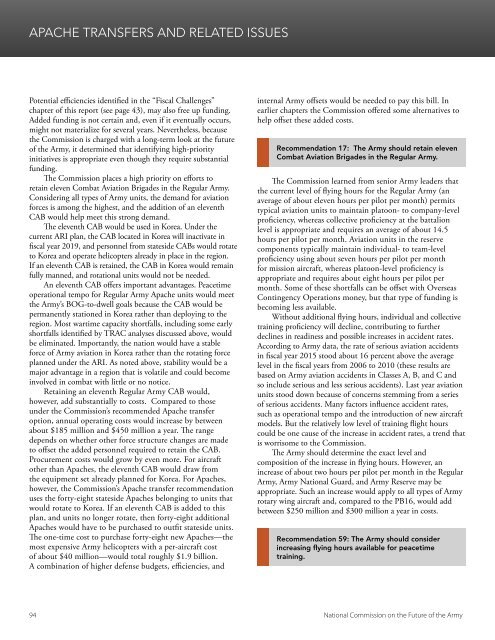THE FUTURE OF THE ARMY
Futurearmy
Futurearmy
You also want an ePaper? Increase the reach of your titles
YUMPU automatically turns print PDFs into web optimized ePapers that Google loves.
APACHE TRANSFERS AND RELATED ISSUES<br />
Potential efficiencies identified in the “Fiscal Challenges”<br />
chapter of this report (see page 43), may also free up funding.<br />
Added funding is not certain and, even if it eventually occurs,<br />
might not materialize for several years. Nevertheless, because<br />
the Commission is charged with a long-term look at the future<br />
of the Army, it determined that identifying high-priority<br />
initiatives is appropriate even though they require substantial<br />
funding.<br />
The Commission places a high priority on efforts to<br />
retain eleven Combat Aviation Brigades in the Regular Army.<br />
Considering all types of Army units, the demand for aviation<br />
forces is among the highest, and the addition of an eleventh<br />
CAB would help meet this strong demand.<br />
The eleventh CAB would be used in Korea. Under the<br />
current ARI plan, the CAB located in Korea will inactivate in<br />
fiscal year 2019, and personnel from stateside CABs would rotate<br />
to Korea and operate helicopters already in place in the region.<br />
If an eleventh CAB is retained, the CAB in Korea would remain<br />
fully manned, and rotational units would not be needed.<br />
An eleventh CAB offers important advantages. Peacetime<br />
operational tempo for Regular Army Apache units would meet<br />
the Army’s BOG-to-dwell goals because the CAB would be<br />
permanently stationed in Korea rather than deploying to the<br />
region. Most wartime capacity shortfalls, including some early<br />
shortfalls identified by TRAC analyses discussed above, would<br />
be eliminated. Importantly, the nation would have a stable<br />
force of Army aviation in Korea rather than the rotating force<br />
planned under the ARI. As noted above, stability would be a<br />
major advantage in a region that is volatile and could become<br />
involved in combat with little or no notice.<br />
Retaining an eleventh Regular Army CAB would,<br />
however, add substantially to costs. Compared to those<br />
under the Commission’s recommended Apache transfer<br />
option, annual operating costs would increase by between<br />
about $185 million and $450 million a year. The range<br />
depends on whether other force structure changes are made<br />
to offset the added personnel required to retain the CAB.<br />
Procurement costs would grow by even more. For aircraft<br />
other than Apaches, the eleventh CAB would draw from<br />
the equipment set already planned for Korea. For Apaches,<br />
however, the Commission’s Apache transfer recommendation<br />
uses the forty-eight stateside Apaches belonging to units that<br />
would rotate to Korea. If an eleventh CAB is added to this<br />
plan, and units no longer rotate, then forty-eight additional<br />
Apaches would have to be purchased to outfit stateside units.<br />
The one-time cost to purchase forty-eight new Apaches—the<br />
most expensive Army helicopters with a per-aircraft cost<br />
of about $40 million—would total roughly $1.9 billion.<br />
A combination of higher defense budgets, efficiencies, and<br />
internal Army offsets would be needed to pay this bill. In<br />
earlier chapters the Commission offered some alternatives to<br />
help offset these added costs.<br />
Recommendation 17: The Army should retain eleven<br />
Combat Aviation Brigades in the Regular Army.<br />
The Commission learned from senior Army leaders that<br />
the current level of flying hours for the Regular Army (an<br />
average of about eleven hours per pilot per month) permits<br />
typical aviation units to maintain platoon- to company-level<br />
proficiency, whereas collective proficiency at the battalion<br />
level is appropriate and requires an average of about 14.5<br />
hours per pilot per month. Aviation units in the reserve<br />
components typically maintain individual- to team-level<br />
proficiency using about seven hours per pilot per month<br />
for mission aircraft, whereas platoon-level proficiency is<br />
appropriate and requires about eight hours per pilot per<br />
month. Some of these shortfalls can be offset with Overseas<br />
Contingency Operations money, but that type of funding is<br />
becoming less available.<br />
Without additional flying hours, individual and collective<br />
training proficiency will decline, contributing to further<br />
declines in readiness and possible increases in accident rates.<br />
According to Army data, the rate of serious aviation accidents<br />
in fiscal year 2015 stood about 16 percent above the average<br />
level in the fiscal years from 2006 to 2010 (these results are<br />
based on Army aviation accidents in Classes A, B, and C and<br />
so include serious and less serious accidents). Last year aviation<br />
units stood down because of concerns stemming from a series<br />
of serious accidents. Many factors influence accident rates,<br />
such as operational tempo and the introduction of new aircraft<br />
models. But the relatively low level of training flight hours<br />
could be one cause of the increase in accident rates, a trend that<br />
is worrisome to the Commission.<br />
The Army should determine the exact level and<br />
composition of the increase in flying hours. However, an<br />
increase of about two hours per pilot per month in the Regular<br />
Army, Army National Guard, and Army Reserve may be<br />
appropriate. Such an increase would apply to all types of Army<br />
rotary wing aircraft and, compared to the PB16, would add<br />
between $250 million and $300 million a year in costs.<br />
Recommendation 59: The Army should consider<br />
increasing flying hours available for peacetime<br />
training.<br />
94 National Commission on the Future of the Army


